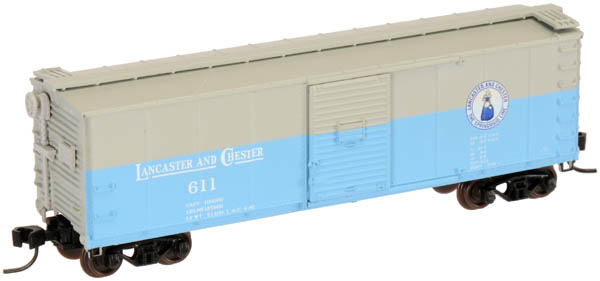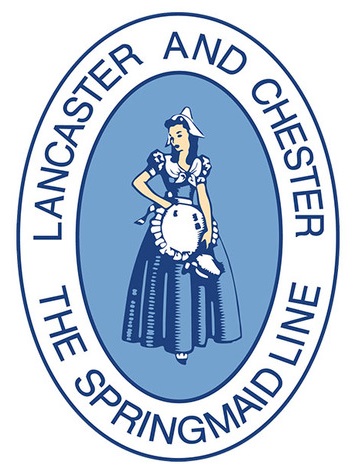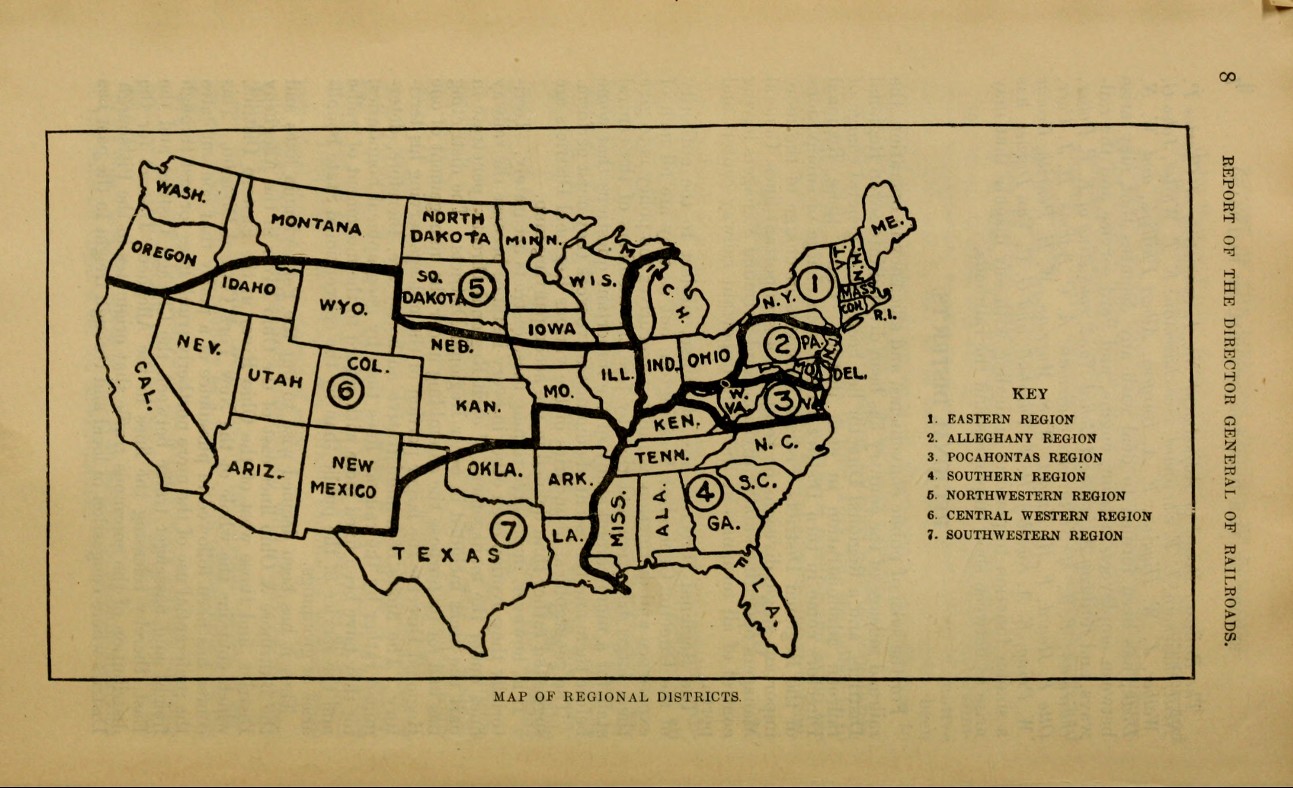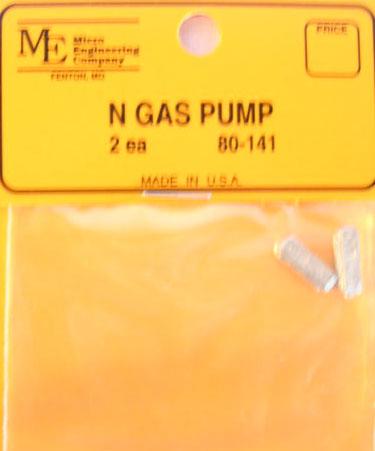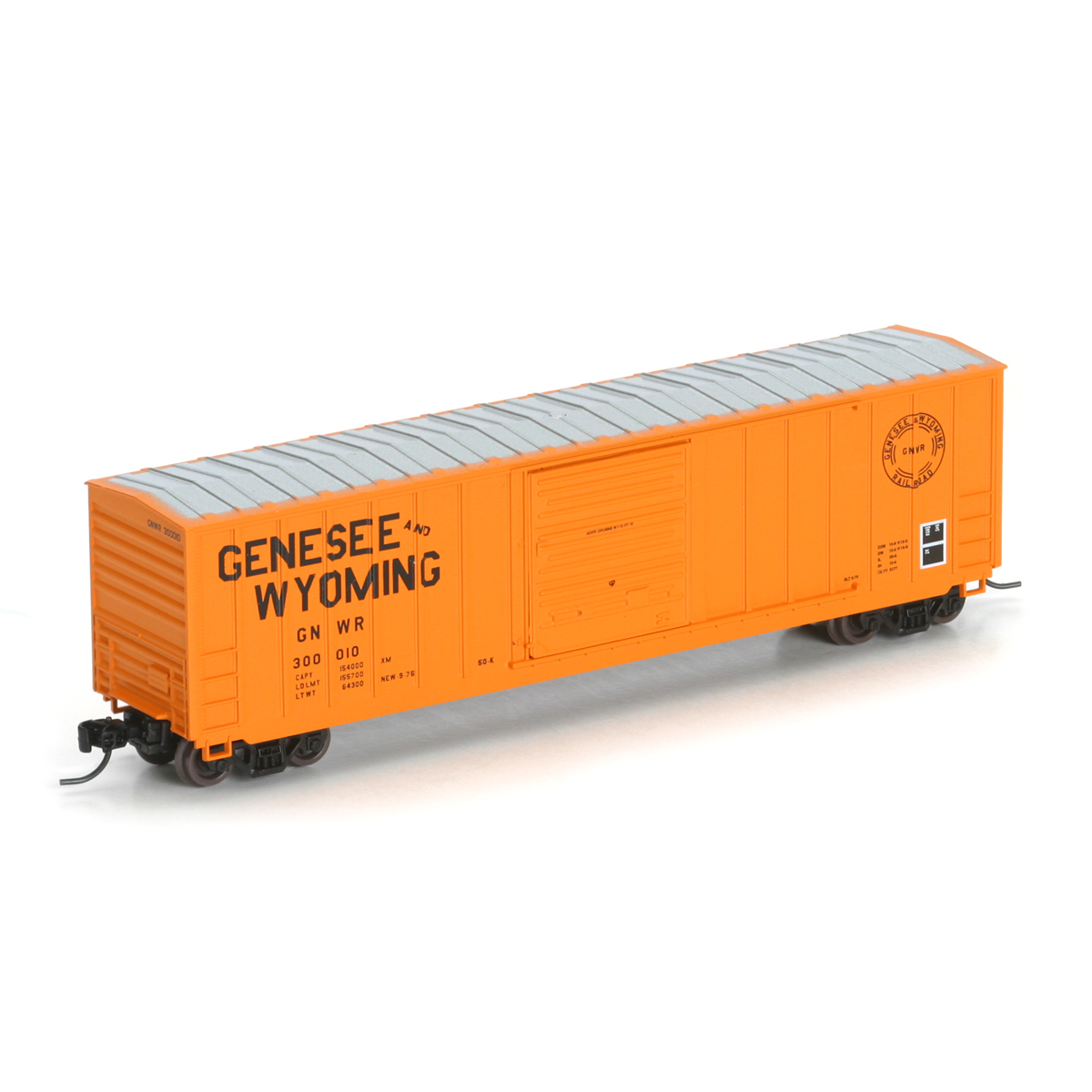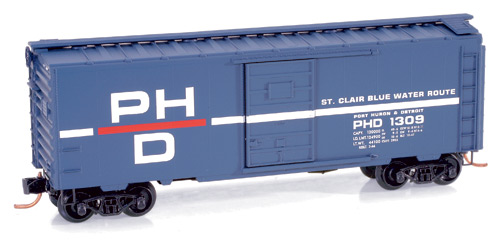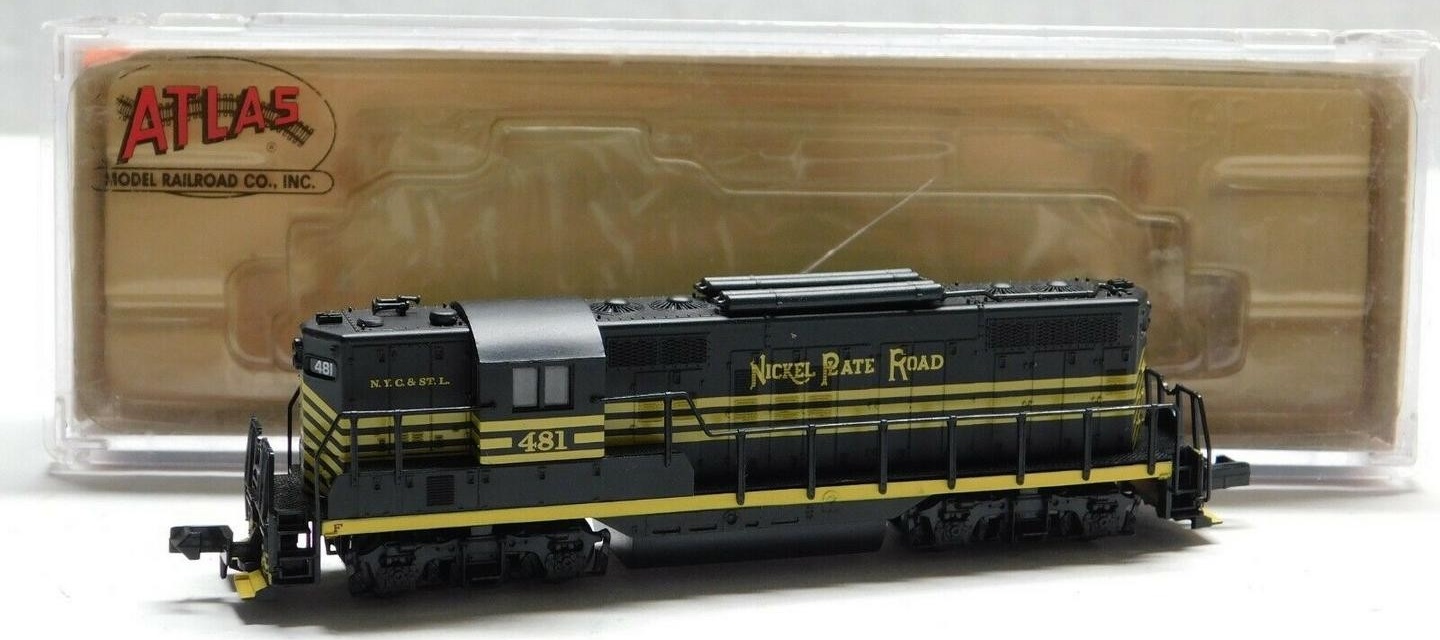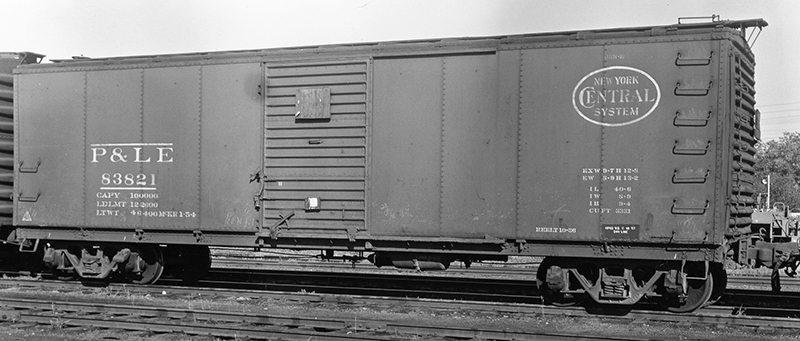Model Information: This Atlas model was announced in June 2006 with an April, 2007 delivery date. It is one of the only Atlas models to feature opening doors. This model features:
Opening Door;
Andrews trucks;
Ready-to-run;
Accurate painting and printing;
AccuMate® couplers;
Brake detail;
Highly detailed body;
Simulated wood or steel door as per the prototype;
Fishbelly or Standard underframe as per the prototype;
Different rib ends (7-8 or 5-5-5) as per the prototype;
Undecorated cars come with both simulated wood or steel door.
Prototype History: By the beginning of WWII, the majority of the classic USRA double-sheathed box cars and their clones were rebuilt with steel sides. More rebuilds followed in the late 1940s and early 1950s. By late 1948, close 14,000 of the original 24,500 USRA double-sheathed cars had been rebuilt with quite a degree of variation including the end, door and underframe. These steel side rebuilds were far more popular than their single-sheathed counterparts.
Road Name History: The L&C began as the Cheraw & Chester in 1873 but the line’s sale on the court house steps to the Spring family in 1896 brought the change in name. The L&C links Lancaster and Chester, North Carolina which is a run of 29 miles. The Spring family owned textile mills along the line.
The early years were pretty rocky. The trestle over the Catawba River burned, followed by a depot a month later. Both were rebuilt. The line was 3’ gauge but by 1902, that was unsustainable and the line was standard gauged. Then in 1913 there was a disastrous wreck of a passenger train on Hooper’s Creek Trestle that killed 5, and wiped out the line’s passenger car fleet and the trestle. That was the end of passenger service for the Lancaster & Chester. Three years later, the bridge over the Catawba River was destroyed again, this time by a flood. The line has 66 curves, some quite sharp. The steepest stretch is Richburg Hill which has a maximum grade of 4.7%.
By the 30’s, the disasters had subsided and the L&C became famous for the use of publicity stunts such as naming 29 vice presidents, one for each mile of line. Gypsy Rose Lee was named Vice President of Unveiling.
The 50’s brought dieselization, first with GE’s and later EMD switchers. All locomotives wear the light blue with white trim and “The Springmaid Line” in the logo (a reference to the Spring’s textile business.)
In recent years, L&C has upgraded their track and bridges, and opened industrial parks along the line. In 2001, L&C bought 31 miles of connecting line from Norfolk Southern running from Lancaster to Kershaw, South Carolina.
This expansion increased traffic dramatically and more locomotives were acquired to augment what had been an all-switcher fleet. As of the end of 2013, the fleet included: three SW900’s, four SW1200’s, two SW1500’s, two GP38-2M’s, two GP38AC’s, and three GP38-2’s.
In 2010, the Spring family sold the L&C to the Gulf & Ohio shortline family. However, it appears for the moment that G&O will preserve the L&C blue paint scheme.
The early years were pretty rocky. The trestle over the Catawba River burned, followed by a depot a month later. Both were rebuilt. The line was 3’ gauge but by 1902, that was unsustainable and the line was standard gauged. Then in 1913 there was a disastrous wreck of a passenger train on Hooper’s Creek Trestle that killed 5, and wiped out the line’s passenger car fleet and the trestle. That was the end of passenger service for the Lancaster & Chester. Three years later, the bridge over the Catawba River was destroyed again, this time by a flood. The line has 66 curves, some quite sharp. The steepest stretch is Richburg Hill which has a maximum grade of 4.7%.
By the 30’s, the disasters had subsided and the L&C became famous for the use of publicity stunts such as naming 29 vice presidents, one for each mile of line. Gypsy Rose Lee was named Vice President of Unveiling.
The 50’s brought dieselization, first with GE’s and later EMD switchers. All locomotives wear the light blue with white trim and “The Springmaid Line” in the logo (a reference to the Spring’s textile business.)
In recent years, L&C has upgraded their track and bridges, and opened industrial parks along the line. In 2001, L&C bought 31 miles of connecting line from Norfolk Southern running from Lancaster to Kershaw, South Carolina.
This expansion increased traffic dramatically and more locomotives were acquired to augment what had been an all-switcher fleet. As of the end of 2013, the fleet included: three SW900’s, four SW1200’s, two SW1500’s, two GP38-2M’s, two GP38AC’s, and three GP38-2’s.
In 2010, the Spring family sold the L&C to the Gulf & Ohio shortline family. However, it appears for the moment that G&O will preserve the L&C blue paint scheme.
Brand/Importer Information: In 1924 Stephan Schaffan, Sr. founded the Atlas Tool Company in Newark, New Jersey. In 1933 his son, Stephan Schaffan, Jr., came to work for his father at the age of sixteen. Steve Jr. built model airplanes as a hobby and frequented a local hobby shop. Being an enterprising young man, he would often ask the owner if there was anything he could do to earn some extra spending money. Tired of listening to his requests, the hobby-store owner threw some model railroad track parts his way and said, "Here, see if you can improve on this".
In those days, railroad modelers had to assemble and build everything from scratch. Steve Jr. created a "switch kit" which sold so well, that the entire family worked on them in the basement at night, while doing business as usual in the machine shop during the day.
Subsequently, Steve Jr. engineered the stapling of rail to fiber track, along with inventing the first practical rail joiner and pre-assembled turnouts and flexible track. All of these products, and more, helped to popularize model railroading and assisted in the creation of a mass-market hobby. The budding entrepreneur quickly outgrew the limitations of a basement and small garage operation. Realizing they could actually make a living selling track and related products, Steve and his father had the first factory built in Hillside, New Jersey at 413 Florence Avenue in 1947. On September 30, 1949, the Atlas Tool Company was officially incorporated as a New Jersey company.
In 1985, Steve was honored posthumously for his inventions by the Model Railroad Industry Association and was inducted into the Model Railroad Industry Hall of Fame in Baltimore, Maryland. In addition, Steve was nominated and entered into the National Model Railroad Association Pioneers of Model Railroading in 1995.
In the early 1990s, the Atlas Tool Company changed its name to Atlas Model Railroad Company, Inc.
In those days, railroad modelers had to assemble and build everything from scratch. Steve Jr. created a "switch kit" which sold so well, that the entire family worked on them in the basement at night, while doing business as usual in the machine shop during the day.
Subsequently, Steve Jr. engineered the stapling of rail to fiber track, along with inventing the first practical rail joiner and pre-assembled turnouts and flexible track. All of these products, and more, helped to popularize model railroading and assisted in the creation of a mass-market hobby. The budding entrepreneur quickly outgrew the limitations of a basement and small garage operation. Realizing they could actually make a living selling track and related products, Steve and his father had the first factory built in Hillside, New Jersey at 413 Florence Avenue in 1947. On September 30, 1949, the Atlas Tool Company was officially incorporated as a New Jersey company.
In 1985, Steve was honored posthumously for his inventions by the Model Railroad Industry Association and was inducted into the Model Railroad Industry Hall of Fame in Baltimore, Maryland. In addition, Steve was nominated and entered into the National Model Railroad Association Pioneers of Model Railroading in 1995.
In the early 1990s, the Atlas Tool Company changed its name to Atlas Model Railroad Company, Inc.
Item created by: RoadRailer on 2017-02-02 17:33:53. Last edited by CNW400 on 2020-06-05 09:21:34
If you see errors or missing data in this entry, please feel free to log in and edit it. Anyone with a Gmail account can log in instantly.
If you see errors or missing data in this entry, please feel free to log in and edit it. Anyone with a Gmail account can log in instantly.


